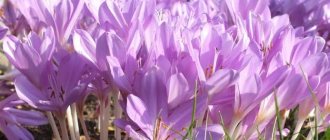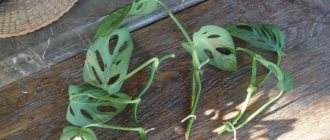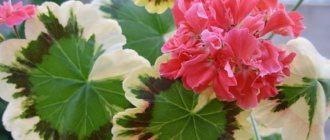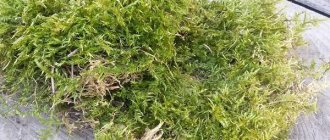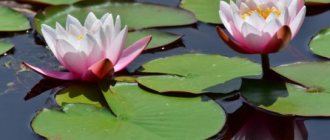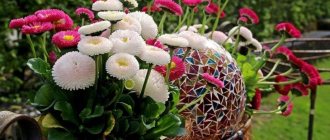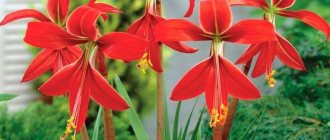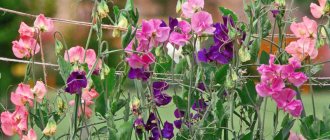The water lily belongs to the water lily family, which includes more than 50 species of perennials with powerful, fleshy rhizomes. A water lily is often mistakenly called a water lily.
This is an amazing flower. The white water lily (the Red Book of Russia includes it as a rare plant) among the Slavs was an obligatory component of various love spells. It was believed that this plant, taken on the road with you, would protect a person from any evil. Carl Linnaeus, a famous biologist who collected legends about this plant, was surprised by the fate of the nymph, rejected by Hercules, and turned into a water lily by the gods. Because of this, he decided to give the flower a Latin name in her honor - white nymphea.
Claude Monet, a French painter, painted “White Water Lilies” in oil on canvas in 1899. He reflected how beautiful the nature that surrounds us is.
Interesting things about the plant
White water lily (water lily) is a natural weather forecaster. There are a huge number of signs of plant behavior depending on the weather.
It has been observed over the years that if the flowers open early in the morning, the weather will be clear all day, while if it appears only at 9 am, it will rain. If it doesn’t appear at all, there will soon be a heavy and prolonged downpour.
Reproduction
The reproduction process occurs thanks to rhizomes and seeds. Even with a strong drop in water level, it will bloom and bear fruit. There are several conditions for a water lily to live:
- Bright places.
- Fresh water.
- Silty soil.
- When in water, it will easily overwinter and survive other weather disasters.
Reproduction of water lilies is possible by divisions, rhizomes, and seeds
Note! White water lily is grown in artificial ponds for use in the production of medicines. It is also a valuable ornamental plant.
Giant water lily in an artificial pond
White water lily: description
It is a stemless perennial herbaceous and aquatic plant with large, floating leaves. It belongs to the water lilies. It has a creeping rhizome, adjacent to it are heart-shaped leaves, as well as long stalks with white single flowers. Flowers with a large number of white petals, emit a light aroma, float on the water. Their calyx is four-leafed and green. Many stamens, radiate multipartite stigma. The fruits are spherical, green, and always ripen under water. Flowering occurs in June-July.
Victoria amazonica: giant water lily
The giant water lily Victoria of the Amazon was discovered in 1832 during the travel of the German naturalist Eduard Poeppig in the Amazon. It is his mention of the plant that is considered the first; earlier ones were ignored.
It is called gigantic because of the extraordinary size of its surface leaves and flowers.
It is considered one of the most beautiful representatives of the nymphaean genus. It is quite rare, most common in the Amazon River basin in Bolivia and Brazil.
Distinctive features of Victoria Amazonian:
- Huge round leaves, up to 50 cm in diameter.
- The cuttings are attached to the center of the leaf.
- The sheet can withstand a weight of more than 30 kg.
- The bright green leaf has “sides” along the edges.
- The reverse side of the leaf is bright burgundy, covered with many small needles.
It blooms only once a year, in December-January. The duration of flowering is 2-3 days, the rest of the time the flower is immersed in water. It blooms exclusively at night; in the late evenings the buds emerge from the water and remain open until the morning.
Places of growth
It grows in the European part of our country, in the southern part of Siberia, in the Urals, Belarus, Ukraine, Eastern Transcaucasia, and the North Caucasus. The white water lily's habitat is standing and slowly flowing water (lakes, ponds, river bays).
Recently, the conditions for the plant to live in nature have been deteriorating, therefore, these days it has been included in the Red Book.
Chemical composition
The beneficial properties of the water lily are due to the rich chemical composition of the roots and leaf plates. The plant contains:
- sugars and starch;
- protein;
- tannins;
- gums and resins;
- tartaric and gallic acids;
- flavonoids;
- antioxidants;
- glycosides and alkaloids;
- ascorbic acid;
- minerals.
The roots of the white water lily contain the alkaloid nympheine. In small dosages, this compound helps improve the condition of cardiovascular diseases and increase the overall tone of the body. However, in excess quantities the substance is dangerous because it leads to disruption of the myocardium.
Harvesting and collection
The period for collecting water lilies is selected depending on the required part of it.
If these are roots, then collection should be carried out in early autumn, when a huge amount of nutrients has already accumulated in them. They are extracted from the bottom using hooks, then cleaned of leaf cuttings and small roots. Then they are washed, cut into equal-sized pieces and dried in a ventilated room or outside in the shade.
If these are buds or flowers of the white water lily plant, then you need to accurately select the time of collection. This should happen during flowering. In addition, they need to be collected before 5 pm, and if just buds, then before 7 am or immediately after 5 pm, since the flowers are submerged under water after this time. Mostly flowers are taken fresh, but if necessary, they are dried in a ventilated, shady place.
The leaves of the plant can be collected in the fall before the onset of cold weather around the clock. The leaves are dried under the same conditions as all other parts - in a ventilated, shady room.
The fruits and seeds of the water lily are collected during its flowering (it must be borne in mind that one flower blooms for only 4 days): for example, the seeds are taken directly from the surface of the water, where they float in “capsules”, while the fruits are taken at a shallow depth under water. Seeds and fruits need to be dried after collection.
Although not only these rules are recommended to be followed by magicians and healers. When various parts of the water lily are torn off, you should always appease the water spirit, since this plant is under its protection: this can be done by throwing a piece of bread or a few coins into the water.
When collecting the plant, you need to remember that the water lily is listed in the Red Books in many countries, therefore, it can only be collected in limited quantities.
Distinctive features and what a water lily looks like
Nymphea is very easy to distinguish from any other plant. It is almost completely submerged in water, except for the surface leaves. Early in the morning the flowers emerge and gradually open. During the day, white water lily flowers cannot be seen in one place.
The light-loving plant moves along the surface of the reservoir in the direction of the sun. After dusk, the buds shrink and sink into the water.
The underwater part of the plant is the stems-rhizomes and underwater leaves. The stems are horizontally immersed in the ground, numerous roots in the form of cords extend from the rhizomes down to the sides, which hold the plant tightly in the ground, leaves and flower stalks grow upward from the roots.
Main types of nymphs:
- Snow White . A distinctive feature is large, 20 cm, dark green leaves and 10 cm, bright white flowers. A flower of this type is viable for 3 to 5 days.
- White . The flowers and leaves are larger than those of the snow-white one. The upper part of the leaves is green and reddish on the reverse side. The color of the buds is creamy, sometimes pink or red.
- Tetrahedral . It is distinguished by small flowers, only up to 5 cm in diameter, white or pink.
- Knobby, tuberous . Large view with white buds. Prefers greater depths of more than 1 m.
- Fragrant . Bright green leaves, painted red on the back, white buds. A water lily of this class has a bright, pleasant aroma.
- Dwarf . Small flowers 2-2.5 cm in diameter, medium bright green leaves with a crimson turnover. They grow in shallow waters up to 30 cm.
- Hybrid . A single name for cultivated species, they have a variety of shapes and colors: yellow, pink, blue, milky, do not grow in the wild.
- Blue . Narrow petals of blue or pink flowers, characterized by a bright, pleasant aroma.
- Brindle, spotted . White buds and variegated underwater leaves. Unlike all its fellows, it blooms at night.
Underwater leaves are different from those that float on the surface. They have an oblong shape with a pointed top and base, rolled up in the shape of a cap, inside which are the flower buds and the embryo of the surface leaf.
Application
The white water lily plant is actively used in folk medicine. An infusion of flowers is used to quench thirst, as a soothing and antipyretic effective remedy. An aqueous infusion of these flowers is used for insomnia as a sleeping pill and sedative.
Medicinal preparations from the rhizomes and roots of the plant help reduce skin inflammation, while when crushed they are used as mustard plasters.
If you add the leaves of the white water lily to the roots of the plant, this decoction will help with constipation and jaundice. The roots, boiled in wort, are consumed by nursing women, thereby increasing the amount of milk.
An alcoholic tincture made from the leaves is drunk for urolithiasis. In case of hair loss, it is recommended to wash your hair with a decoction of the roots of the plant.
The infusion, which is prepared from the flowers of this medicinal plant, is used for baths and washes, in addition to relieving pain as an external remedy.
Dry rhizomes can be ground into flour and baked into bread.
Planting and caring for water lilies
The snow white lily is a rare plant , but it is not difficult to grow. Water lilies should be planted in calm, still water, away from fountains or strong water currents, from mid-May to late June.
Planting is done directly into the ground in plastic containers - this will better secure the rhizome and protect it from being washed away in the event of unexpected stormy water flows.
The substrate should consist of 2/3 heavy, clay soil and 1/3 peat. White water lilies develop well in soft and acidic water at a pH of 5.5−7.0.
The plant's flowers love sun , and only a few varieties thrive in a partially shaded pond.
Once every 3-4 years, when the leaves begin to grow above the surface of the water and the flowers become smaller and quickly fade, the rhizome should be dug up in the spring and divided into several parts, then planted again.
It is advisable to fertilize the plants annually. Fertilizers containing nitrogen should be used. Fertilizers for water lilies should in no way contain phosphorus - this leads to the development of algae, which is undesirable for the inhabitants of a pond or stream.
In spring (until mid-June), snow-white flowers can be fertilized with horn flour; it contains about 15% nitrogen and is not soluble in water; it is decomposed only by microorganisms in the root zone of the plant. About 50 g of fertilizer is needed. In winter, if the reservoir freezes to the bottom, it is necessary to dig up the water lilies and store them in water in a room protected from low temperatures.
Beautiful pond decoration
There is a beautiful legend about green tea and white water lily . If you place green tea in a blooming flower at dawn and collect it at the end of the day, then drinking it, a person will gain the necessary vitality.
If a water lily has settled in your pond , then an interesting solution would be the appearance of fish in it. Fish not only decorate the pond, but also serve as good helpers for flowers.
The most popular fish will be Koi carp and comets. They are extraordinarily beautiful. Comets are more mobile and live in the upper layers of the reservoir; moreover, they do not disturb the flowers. And carp are more fussy, rushing around in plants and making a mess.
If the reservoir is large (2-3 meters deep), then carp will fit into the picture better. If the body of water is small (up to 70 centimeters), then opt for a comet.
Criteria for choosing water lilies
All nymphs are divided into frost-resistant and tropical. It is more desirable to breed the former in Russian latitudes, but the latter can also be grown if they are moved indoors for the winter. Otherwise, they simply will not survive the frost.
Another important criterion for choosing nymphs is the size of the flowers, because too large will be uncomfortable in small ponds, and, conversely, small buds will simply be lost in large ponds.
Even after they are fully grown, dwarf lilies will cover small areas. These flowers are ideal for small containers. They are planted in decorative buckets, tubs and trays. These varieties include Aurora, Helvola, Paul Hariot, etc. Small lilies are suitable for reservoirs with a depth of 30 cm. After growth, they occupy an area of up to 1 square meter. m.
Medium lilies look great in a large pond. Having reached maximum growth, they will cover several square meters. For such nymphs, a planting depth of 1 to 2 m will be required. You can choose from Chromatella, Albida or Attraction varieties.
The range of varietal water lilies is very wide
Why is water lily useful?
Medicinal white water lily is used to treat numerous acute and chronic diseases. In particular, the plant:
- normalizes the functioning of the genitourinary system and removes swelling;
- helps with abscesses, boils and festering wounds;
- relieves inflammatory processes;
- eliminates muscle cramps;
- improves the condition of neurological diseases;
- restores energy and helps get rid of depression;
- relieves tooth and joint pain;
- has a beneficial effect on the liver and helps in the treatment of jaundice;
- reduces high fever during colds;
- normalizes sleep;
- improves well-being during cystitis and removes sand from the kidneys and bladder;
- relieves swelling;
In home cosmetology, white water lily is used to lighten the epidermis and eliminate age spots. Decoctions and infusions based on the plant help get rid of dandruff and normalize oily scalp.
White water lily acts as a mild natural laxative

